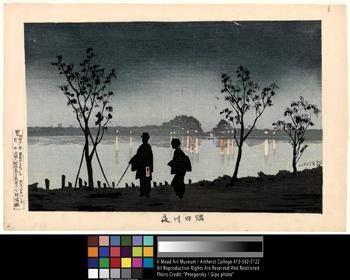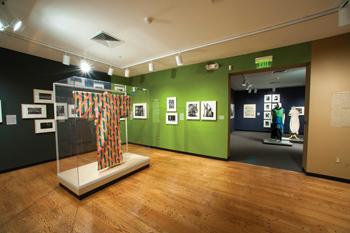Picturing Tokyo
By Emily Gold Boutilier
The idea for the Mead’s current special exhibition arose, appropriately, from an undergraduate course. First taught in 2009, “Reinventing Tokyo: The Art, Literature and Politics of Japan’s Modern Capital” was conceived by three professors—Trent Maxey, Samuel Morse and Timothy Van Compernolle—as an interdisciplinary look at how Tokyo has changed over the past century and a half.
The exhibition, Reinventing Tokyo: Japan’s Largest City in the Artistic Imagination, was curated by Morse and designed to complement the course. “It’s the kind of thing one can only do at a small college museum,” Morse says. “At the same time, it’s an exhibition that any major museum would be proud to put on.”
Indeed, it is the first exhibition in the United States to artistically examine Tokyo and its transformations. What’s more, says Mead Director Elizabeth Barker, the exhibition is the first to consider Tokyo as an inspiration for artists—“as a motor for stylistic change in other artistic forms.”
Its more than 100 prints, photographs, paintings and textiles document the evolution of a pre-modern city ruled by a warlord, to one modeled on Western capitals before World War II, to a global economic powerhouse during the postwar decades and to the global metropolis of today.

Night on the Sumida River (Sumidagawa yoru)
Meiji era, 1881
Horizontal ōban woodblock print, ink and color on paper
24.5 x 36.8 cm (9 5/8 x 14 1/2 in.)
Mead Art Museum, Amherst College; AC 2008.41
Purchase with Wise Fund for Fine Arts
Forty-four pieces are from the Mead’s permanent collection. Among them are late-19th-century woodblock prints by Kobayashi Kiyochika that explore the visual effects of lamplight on the city. (“The pre-modern city had been dark,” Morse explains.) Several other works are on loan from Japan and on display in this country for the first time. These include a striking photograph by Kageyama Koyo of a family during a 1944 air raid drill. Another work, a painting of a contemporary industrial suburb by Yamaguchi Hidenori, was completed specifically for the exhibition.

Barker credits Morse with creating an art show grounded in pedagogy. “City art museums don’t have professors who are in regular contact with the curators,” she adds. “The truth is, we would never acquire a work of Japanese art without consulting Sam. He’s one of our best curators, and he’s not even on the payroll.”
See for Yourself
Reinventing Tokyo is on view through Dec. 30. The exhibition catalog that Morse edited features essays by, among others, Pulitzer Prize-winning historian John W. Dower ’59 and Professors Maxey and Van Compernolle. In addition, Frost Library has a complementary exhibition of Tokyo-related books.